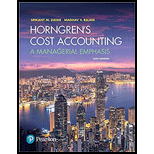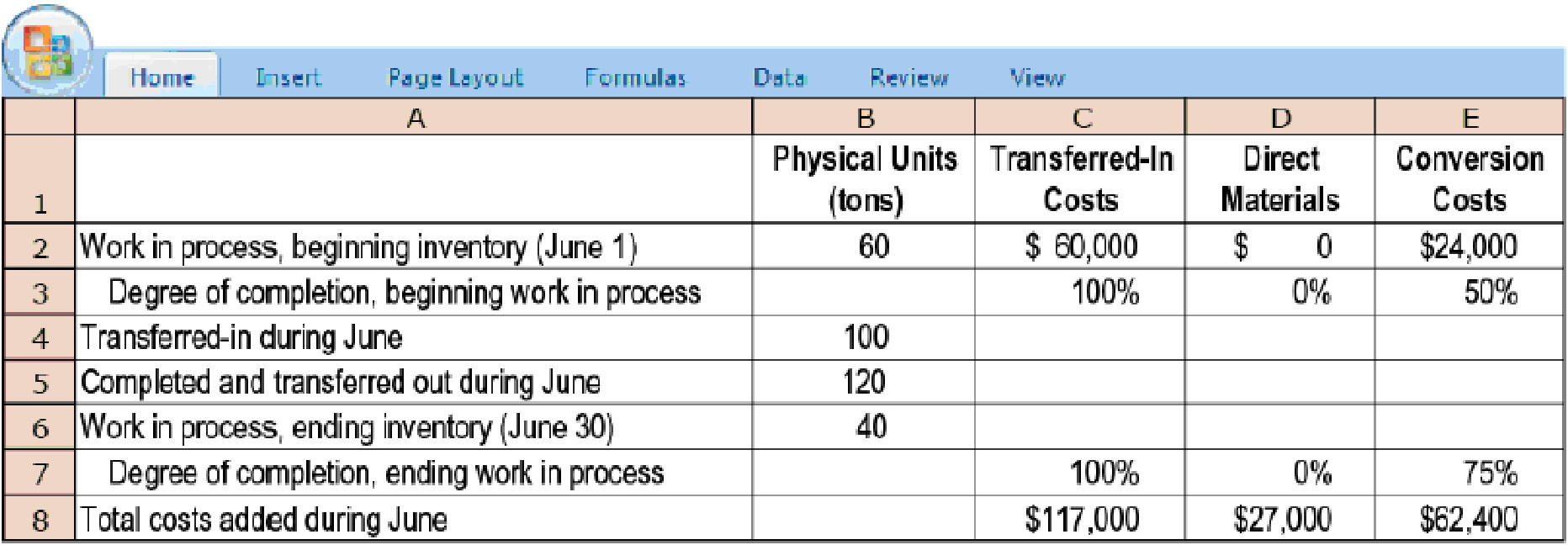
EBK HORNGREN'S COST ACCOUNTING
16th Edition
ISBN: 9780134475998
Author: Rajan
Publisher: YUZU
expand_more
expand_more
format_list_bulleted
Concept explainers
Textbook Question
Chapter 17, Problem 17.31E
Transferred-in costs, weighted-average method. Trendy Clothing, Inc. is a manufacturer of winter clothes. It has a knitting department and a finishing department. This exercise focuses on the finishing department. Direct materials are added at the end of the process. Conversion costs are added evenly during the process. Trendy uses the weighted-average method of

- 1. Calculate equivalent units of transferred-in costs, direct materials, and conversion costs.
Required
- 2. Summarize the total costs to account for, and calculate the cost per equivalent unit for transferred-in costs, direct materials, and conversion costs.
- 3. Assign costs to units completed (and transferred out) and to units in ending work in process.
Expert Solution & Answer
Learn your wayIncludes step-by-step video

schedule06:15
Students have asked these similar questions
Novak supply company a newly formed corporation , incurred the following expenditures related to the land , to buildings, and to machinery and equipment.
abstract company's fee for title search $1,170
architect's fee $7,133
cash paid for land and dilapidated building thereon $195,750
removal of old building $45,000
LESS: salvage $12,375 $32,625
Interest on short term loans during construction…
Year
Cash Flow
0
-$ 27,000
1
11,000
2
3
14,000
10,000
What is the NPV for the project if the required return is 10 percent?
Note: Do not round intermediate calculations and round your answer to 2 decimal places, e.g., 32.16.
NPV
$ 1,873.28
At a required return of 10 percent, should the firm accept this project?
No
Yes
What is the NPV for the project if the required return is 26 percent?
The following were selected from among the transactions completed by Babcock Company during November of the current year:
Nov.
3
Purchased merchandise on account from Moonlight Co., list price $85,000, trade discount 25%, terms FOB destination, 2/10, n/30.
4
Sold merchandise for cash, $37,680. The cost of the goods sold was $22,600.
5
Purchased merchandise on account from Papoose Creek Co., $47,500, terms FOB shipping point, 2/10, n/30, with prepaid freight of $810 added to the invoice.
6
Returned merchandise with an invoice amount of $13,500 ($18,000 list price less trade discount of 25%) purchased on November 3 from Moonlight Co.
8
Sold merchandise on account to Quinn Co., $15,600 with terms n/15. The cost of the goods sold was $9,400.
13
Paid Moonlight Co. on account for purchase of November 3, less return of November 6.
14
Sold merchandise with a list price of $236,000 to customers who used VISA and who redeemed $8,000 of pointof- sale coupons. The cost…
Chapter 17 Solutions
EBK HORNGREN'S COST ACCOUNTING
Ch. 17 - Give three examples of industries that use...Ch. 17 - In process costing, why are costs often divided...Ch. 17 - Explain equivalent units. Why are equivalent-unit...Ch. 17 - What problems might arise in estimating the degree...Ch. 17 - Name the five steps in process costing when...Ch. 17 - Name the three inventory methods commonly...Ch. 17 - Describe the distinctive characteristic of...Ch. 17 - Describe the distinctive characteristic of FIFO...Ch. 17 - Prob. 17.9QCh. 17 - Identify a major advantage of the FIFO method for...
Ch. 17 - Identify the main difference between journal...Ch. 17 - The standard-costing method is particularly...Ch. 17 - Why should the accountant distinguish between...Ch. 17 - Transferred-in costs are those costs incurred in...Ch. 17 - Theres no reason for me to get excited about the...Ch. 17 - Assuming beginning work in process is zero, the...Ch. 17 - The following information concerns Westheimer...Ch. 17 - Sepulveda Corporation uses a process costing...Ch. 17 - Penn Manufacturing Corporation uses a...Ch. 17 - Kimberly Manufacturing uses a process-costing...Ch. 17 - Equivalent units, zero beginning inventory....Ch. 17 - Journal entries (continuation of 17-21). Refer to...Ch. 17 - Zero beginning inventory, materials introduced in...Ch. 17 - Weighted-average method, equivalent units. The...Ch. 17 - Weighted-average method, assigning costs...Ch. 17 - FIFO method, equivalent units. Refer to the...Ch. 17 - FIFO method, assigning costs (continuation of...Ch. 17 - Operation costing. The Carter Furniture Company...Ch. 17 - Weighted-average method, assigning costs....Ch. 17 - FIFO method, assigning costs. 1. Do Exercise 17-29...Ch. 17 - Transferred-in costs, weighted-average method....Ch. 17 - Transferred-in costs, FIFO method. Refer to the...Ch. 17 - Operation costing. Egyptian Spa produces two...Ch. 17 - Standard-costing with beginning and ending work in...Ch. 17 - Equivalent units, comprehensive. Louisville Sports...Ch. 17 - Weighted-average method. Hoffman Company...Ch. 17 - Journal entries (continuation of 17-36). Required...Ch. 17 - FIFO method (continuation of 17-36). 1. Do Problem...Ch. 17 - Transferred-in costs, weighted-average method...Ch. 17 - Transferred-in costs, FIFO method (continuation of...Ch. 17 - Weighted-average method. McKnight Handcraft is a...Ch. 17 - FIFO method (continuation of 17-41). 1. Complete...Ch. 17 - Transferred-in costs, weighted-average method....Ch. 17 - Transferred-in costs, FIFO method. Refer to the...Ch. 17 - Standard costing, journal entries. The Warner...Ch. 17 - Multiple processes or operations, costing. The...Ch. 17 - Benchmarking, ethics. Amanda McNall is the...
Additional Business Textbook Solutions
Find more solutions based on key concepts
(Record inventory transactions in the periodic system) Wexton Technologies began the year with inventory of 560...
Financial Accounting (12th Edition) (What's New in Accounting)
(Interest rate determination) You’re looking at some corporate bonds issued by Ford, and you are trying to det...
Foundations Of Finance
E3-18 Comparing cash and accrual basis accounting and applying the revenue recognition principle
Learning Ob...
Horngren's Accounting (12th Edition)
4. JC Manufacturing purchase d inventory for $ 5,300 and al so paid a $260 freight bill. JC Manufacturing retur...
Horngren's Financial & Managerial Accounting, The Financial Chapters (Book & Access Card)
Explain how to derive a total expenditures (TE) curve.
Macroeconomics
Knowledge Booster
Learn more about
Need a deep-dive on the concept behind this application? Look no further. Learn more about this topic, accounting and related others by exploring similar questions and additional content below.Similar questions
arrow_back_ios
SEE MORE QUESTIONS
arrow_forward_ios
Recommended textbooks for you
- Principles of Accounting Volume 2AccountingISBN:9781947172609Author:OpenStaxPublisher:OpenStax College
 Principles of Cost AccountingAccountingISBN:9781305087408Author:Edward J. Vanderbeck, Maria R. MitchellPublisher:Cengage Learning
Principles of Cost AccountingAccountingISBN:9781305087408Author:Edward J. Vanderbeck, Maria R. MitchellPublisher:Cengage Learning Cornerstones of Cost Management (Cornerstones Ser...AccountingISBN:9781305970663Author:Don R. Hansen, Maryanne M. MowenPublisher:Cengage Learning
Cornerstones of Cost Management (Cornerstones Ser...AccountingISBN:9781305970663Author:Don R. Hansen, Maryanne M. MowenPublisher:Cengage Learning  Managerial Accounting: The Cornerstone of Busines...AccountingISBN:9781337115773Author:Maryanne M. Mowen, Don R. Hansen, Dan L. HeitgerPublisher:Cengage Learning
Managerial Accounting: The Cornerstone of Busines...AccountingISBN:9781337115773Author:Maryanne M. Mowen, Don R. Hansen, Dan L. HeitgerPublisher:Cengage Learning Excel Applications for Accounting PrinciplesAccountingISBN:9781111581565Author:Gaylord N. SmithPublisher:Cengage Learning
Excel Applications for Accounting PrinciplesAccountingISBN:9781111581565Author:Gaylord N. SmithPublisher:Cengage Learning

Principles of Accounting Volume 2
Accounting
ISBN:9781947172609
Author:OpenStax
Publisher:OpenStax College

Principles of Cost Accounting
Accounting
ISBN:9781305087408
Author:Edward J. Vanderbeck, Maria R. Mitchell
Publisher:Cengage Learning

Cornerstones of Cost Management (Cornerstones Ser...
Accounting
ISBN:9781305970663
Author:Don R. Hansen, Maryanne M. Mowen
Publisher:Cengage Learning

Managerial Accounting: The Cornerstone of Busines...
Accounting
ISBN:9781337115773
Author:Maryanne M. Mowen, Don R. Hansen, Dan L. Heitger
Publisher:Cengage Learning

Excel Applications for Accounting Principles
Accounting
ISBN:9781111581565
Author:Gaylord N. Smith
Publisher:Cengage Learning
Cost Accounting - Definition, Purpose, Types, How it Works?; Author: WallStreetMojo;https://www.youtube.com/watch?v=AwrwUf8vYEY;License: Standard YouTube License, CC-BY